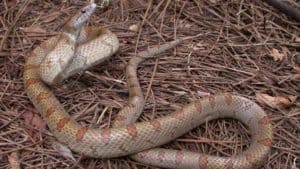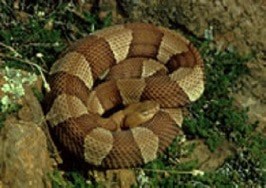
Spring is right around the corner, or if you’re in a state like Iowa you enjoyed two weeks of it before 3rd winter showed up for a week, and that means aside from yourself plenty of wildlife is also making its way back out.
This includes snakes, venomous and not. While the far majority of snakes are perfectly harmless, and even most of the venomous ones would rather be left alone and run away at the first sight of a person, snake bites do happen and you want to make sure you understand potential dangers in your area.
This includes learning how to identify copperheads (the most likely venomous U.S. snakes to bite a human) versus those many copies.
If you live in an area with copperheads, that means being able to identify them quickly, as well as the multiple non-venomous snakes that often look like copperheads.
Bites from a copperhead are the least likely venomous snake bites to kill a healthy adult, but they are also the most likely to strike. Those bites still require medical treatment and those medical bills (even with insurance) can be five figures or more.
Copperheads are known for blending in, and there are several look-alike snakes that are often mistaken for the venomous version because of similar patterns and coloring – which is a beneficial survival mechanism to non-venomous snakes.
So how can you tell actual copperhead pit vipers from non-venomous water snakes that often have similar patterns? Read on to find out!
Table of Contents
What Do Copperheads Look Like?
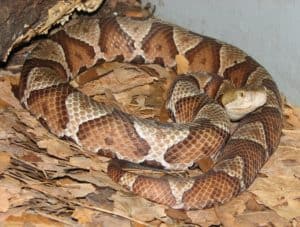
True to their name, generally copperheads are a combination of various shades of deep copper and tan, a combination that is insanely good for camouflage but is also copied by many other snakes sharing their habitat. That can easily cause confusion, especially when there are local variations in shade of color or you have individuals who are mildly color blind – that definitely throws a wrench in identification!
While this is a solid base of similar colors, they can vary a bit into grays and young baby copperhead snakes often even have yellow or yellowish tails. Regional variances occur, but the base look of most copperheads will be the same most of the time: copper, tan, brown, rust – with especially dark hour glass blotches down the body.
There are some sub-species that can have a more grayish tint, and very young copperheads will often have very bright yellow tails that should act as an immediate red flag.
If you see a bright yellow tail, give the snake plenty of space because that’s a major tell-tale sign of a young (under one year old) copperhead.
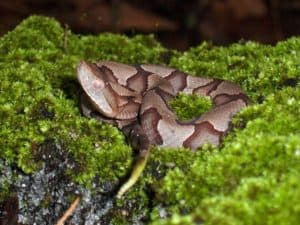
A really good picture of this is the one off to the right here. This is a young venomous copperhead snake, and a lighter shade than what most people think of when it comes to copper, tan, brown, etc. Notice the yellow tail on this one – a clear indication that this is a young copperhead that is less than a year old.
This picture also shows a pretty good “hour glass” that is really thin in the middle and looks a little different but is still easy to identify. Since the classic “hour glass” identification isn’t always 100% perfect (or connected) it’s good to see several examples.
Even early on, that pattern is still very present on young copperhead snakes and will only continue to darken and form as they age and grow.
There are also a few other dead giveaways. Triangular heads almost always are a give away of a pit viper (although the hog snake has a weird defense mechanism where it can puff up the head that can make it look somewhat similar), and if you see actual fangs, that’s a copperhead…and you’re almost certainly standing way too close to an agitated snake.
The hour glass pattern can look like a Hershey’s Kiss candy from the side, and they don’t always have to connect, the patterns can be broken up. The hour glasses tend to be the most solid near the middle of the body, but the sides should always be clearly thicker than the middle – hence the stem or “hour glass” look.
Which Snakes Look Like Copperheads?

There are several snakes that look like copperheads and are often mistaken for this venomous pit viper – which actually tells you their camouflage is working the way it’s supposed to! Good for the non-venomous snakes, not so great for those of us trying to tell the difference.
Depending on which area you’re in the most common copperhead copycat can vary, but almost all of them will be one of these species of snakes.
This will help you tell them apart but as always, if in doubt: just leave them be!
A short list of common copperhead look-alikes include:
- Corn snake (probably one of the two most common copperhead imposter)
- Northern water snake (this is the other most common perpetrator that is mis-identified as a copperhead)
- Eastern hognose snakes
- Black racer snakes
- Mole king snake
- Eastern rat snake
Copperheads versus corn snakes

Especially for people with minor color blindness, it can be easy to mistake the color of the reddish brown or rust corn snakes for the tan, light brown, copper/rust colored copperheads. Also often referred to as a “red rat snake” in some regions, the corn snake is very brightly colored snake that is redder than the copperhead.
While it’s blotches can look very similar to the back pattern of a copperhead at first glance, a little bit of a study shows they’re not hourglass in shape at all.
This is a very good way to tell the two apart. The blotches on a corn snake never extend all the way down the side and to the ground, and they also tend to be thick in the middle whereas on copperheads the splotches tend to be thick on each side and thin in the middle, like an hour glass or two Hershey’s Kisses candy with the thin stems meeting in the middle.
Generally speaking, copperhead tend to be much thicker in body than your average corn snake although this can’t always be a reliable indicator since a really young copperhead can be thin in size while a large adult corn snake who just ate will be plenty thick.
Rusty or reddish-copper corn snakes can be found in a wide array of areas and in fact have a larger habitat than copperheads, and can pretty much be found wherever the venomous copperhead can be found throughout the United States, as well.
Remember in copperheads vs. corn snakes:
- Corn snakes are redder
- Corn snakes have thick blotches only on the back while copperheads have thick side blotches or “hourglasses”
- Corn snakes have small angular heads, copperheads have triangular heads
- Corn snakes tend to be thinner in body (don’t rely solely on this one)
Find more on corn snakes from this article on Wikipedia.
Copperheads versus northern water snakes
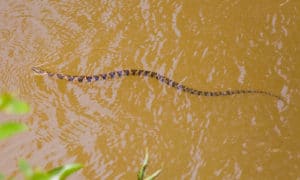
Northern water snakes are another species of harmless snakes that are commonly mistaken for the venomous copperhead. This will make sense to a lot of outdoor enthusiasts but it might also confuse some so right off the bat: the colors and to some extent even the patterns of the northern watersnake can differ IMMENSELY between one location to another.
However as the picture above shows, and there are many great websites with various close ups of big thick looking water snakes, there are some of these snakes that are large, thick, and feature a very copper and brown look with darker bands across the body.
At a glance a large northern water snake in many areas can definitely set off the red caution flag in your brain.
There are a few main differences to focus on. The shape of the head is a big one. If you can’t tell where the “neck” ends and the head begins, chances are it’s a water snake. On the other hand if their is a distinctive triangular or “arrowhead” appearance to the head, that’s a classic sign of a pit viper, which the copperhead is.
Another way is to look at the actual pattern. An hourglass pattern means that the bands will be thick, then thin over the back, then thick again on the other side. The opposite is true with northern watersnakes, who will always have very narrow bands on the side of the body while it is really wide and thick on the back.
In other words, it’s the exact inverse/opposite of a copperhead’s pattern.
Remember when comparing copperheads to water snakes
- Look at the shape of the head (smooth versus triangle)
- Are the bands thick-thin-thick (copperhead) or thin-thick-thin (water snake)
- The coloration of water snakes tends to be a bit darker, more reddish-brown than the copper rust tan of the copperhead
Great University of Georgia article on the northern water snake.
Copperheads versus eastern hognose snakes
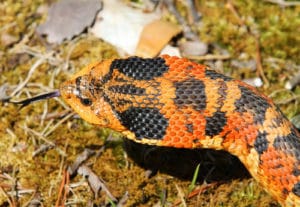
The eastern hognose snake is one of those that comes in a surprising number of colors and patterns to the point that you can have several of these snakes together and they will look like completely different species to those of us who aren’t professional biologists or herpetologists.
These snakes are known for being the “thespians of the reptile world” because they defend themselves by acting in a variety of ways, depending on what’s working or what the situation calls for. They are known especially for puffing out their necks to attempt to look big and intimidating, or even like a pit viper, hiss really loudly, and even strike at a potential threat (although with their mouths closed since they don’t really have the fangs). These snakes will even roll over and play dead as a desperation play.
That’s certainly a wide acting range, isn’t it?
Preferring really sandy soil and mostly feeding on toads, these can often be mistaken for smaller or younger copperheads in some regions where the coloration is similar, and the puffed out neck definitely works to cause hesitation.
That being said, even with the ones that look kind of similar, a simple study of the eyes, the back pattern, and the neck/head should make it easy to tell the non-venomous hognose snake apart from a venomous copperhead.
Remember when comparing copperheads to the eastern hognose snake:
- Look for the hour glass pattern that copperheads have – the eastern hognose snake will generally have back blotches with so side spots
- Even puffed out, the hognose snake won’t look like a triangular head
- The eyes of this snake look black as opposed to the yellow/copper of a copperhead’s eyes
Learn more about the eastern hognose snake here.
Copperheads versus black racer snakes
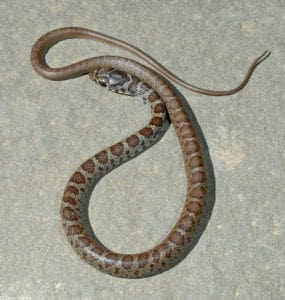
This is not a mistake likely to be made with full grown adults, seeing has how eventually most black racers are a solid black color (hence the fitting name) that makes them virtually impossible to mistake for a copperhead, though ironically might get them mistaken for a water moccasin in some places, but as small babies or juveniles, many of these have more of a light green, brown, or copper type color and clear back splotches that look far different than anything you would think of as a black racer.
Take a look to the left for a great example of a black racer that looks anything but. While this closeup makes it easy to see one of these is definitely not a copperhead, if you see one darting through some leaves and only see a flash of its back, that could make you wonder.
This blotched pattern is something that goes away as black racers age although some may keep it for several years. However, it’s important to note that when looking at smaller potentially juvenile copperheads, the black racer lookalike should be easy to tell apart if you can see the entire snake as young copperheads have that very distinctive yellow tail that would make them stick out.
The back splotches on racers will be thick circles on the back and light or non-existent on the side but remember that the middle of a copperhead’s back is where the thinnest part of the hourglass band will be found.
Finally, this is another time where the head should be a dead giveaway. Even as a juvenile, copperheads have a triangular arrow-head shaped head that is very distinctive, and while a racer’s eyes will appear black a copperhead’s eyes will be yellow.
Even with small juvenile snakes, these obvious traits will help you tell the difference between the venomous copperheads and the non-venomous black racer look-alikes.
Many people think of black racers as being small quick snakes, and they’re small when young but as this YouTube video shows, they can grow to a pretty big and thick size.
Remember when comparing copperheads to black racer snakes:
- Juvenile copperheads have a distinctive bright yellow tail
- Hourglass back vs. basic splotches
- Look at the head – wide and triangular or narrow and aerodynamic?
Learn more about black racer snakes at this website.
Copperheads versus mole kingsnakes
The mole kingsnake is another one where the colors and patterns can vary quite a bit from one region to another and like the black racer, mole kingsnakes often start off heavily patterened as juveniles and those patterns fade as they get older and normally become more of a solid uniform brown color, though there are some that manage to keep some type of a pattern over the long term.
There are several clear giveaways that can help you to tell these apart from the venomous copperhead pit viper, however.
For one, the blotches on these snakes tend to be very narrow and uniform in shape. They’re not hourglass shaped, usually are small ovals, and they are consistently much smaller or thinner than what you would expect from a copperhead of equal size. On many kingsnakes they are more of a reddish-brown than a rust-brown (though if you’re color blind, don’t trust your eyes on that one).
Mole kingsnakes tend to have small black eyes and small narrow heads. Neither of these are true of copperheads, which will have distinctive triangular heads and yellowish eyes.
One thing that’s worth noting is that most of thee snakes are very rarely out in the open but they are very common under cover like plywood, tin, firewood piles, etc. They are most often out in the open after a heavy rain, so that’s a time you’re morel likely to see these potential copperhead lookalikes.
Remember when comparing copperheads and brown mole kingsnakes:
- Look at the eyes and head: this is a clear giveaway to which is which
- Look for thin back bands (kingsnake) versus hour glass back bands (copperhead)
- These snakes have small red markings on the head that the copperhead will not share
Learn more about the mole kingsnake with this article.
Copperheads versus eastern rat snakes
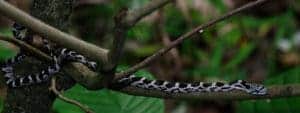
This is another one of those species that only looks similar to a copperhead during the juvenile months and years, as over time the eastern rat snake goes from a distinctive and strong pattern of gray or brown blotches to a nearly completely solid black snake. However some of the early ones are brown with a spotted pattern that can throw people off, especially since splotches are not only on the back but also often the sides on this species.
The eastern rat snake (which is often called the blackrat snake) is a harmless non-venomous snake that is very good for the local environment especially with rodent control. These patterns that can cause them to be confused with the more venomous and potentially dangerous copperhead when they’re younger.
These are often found by humans because unlike copperheads, they will look at basements or attics as good places to ride out the winter while the venomous copperhead the far majority of time will avoid these places.
The common signs are how to tell these two apart. Eastern rat snakes have narrow heads versus the copperhead’s triangular heads, very different looking eyes, and the distinctive hour glass pattern on a copperhead is going to stick out and be absent from the heavily spotted juvenile Eastern rat snakes.
Also, these snakes will often beat their tails against leaves to try and imitate a rattler, something that copperheads will not do.
Remember when comparing eastern rat snakes to copperheads
- Look at the shape of the head and color of the eye
- Watch for the snake trying to imitate a rattlesnake by thumping its tail
- Heavy gray means ratsnake
- The spot pattern vs hourglass pattern
Learn more about the Eastern ratsnake here.
Best Way to Tell Copperheads & Copperhead Look Alikes Apart
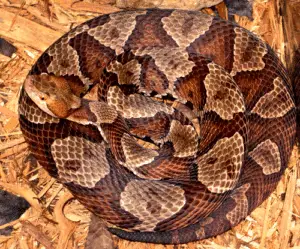
Well the best way to go about this is to emphasize the heavier tell-tale signs that you are dealing with a copperhead and then move on to a snake to snake comparison.
While there are certain biological differences like single scales (instead of double) behind the anal plate or a certain nostril slit or the heat sensing pit under the eyes – but a lot of these are not going to be easy to see or clearly make out unless you’re a trained biologist…and even then you might be closer than you want to be.
So while those do exist (visit the Virginia Herpetological Society page we link to near the end of this article to learn more – it’s an amazing page on copperheads – one of the best online, IMO) we focus on the tell-tale signs that people will be able to commonly see and notice from a safe distance.
If you want to safely identify a copperhead then look for these following major traits:
The head doesn’t lie
A copperhead is a pit viper, and pit vipers have a very distinctive head shape compared to other snakes that helps make them much easier to identify, especially in the United States. Copperheads have a triangular head that is thick at the base and narrows out at the end and is often referred to as an “arrowhead shape.”
This allows space for the fangs and venom glands that make it so important to be wary of these snakes. While the hognose snake can puff out its neck, when you look at the shape it will be distinctly different from the appearance a copperhead sports.
This is a huge tell-tale sign of a venomous snake, and in combination with copper coloring and dark rust bands almost certainly points to a copperhead snake.
Neither does a bright yellow tail
Juvenile copperheads have a stunning bright yellow tail, one that completely sticks out and certainly sets it apart from virtually any other similar looking snake. This is a clear warning to stay away. If you see a copper, tan, rust colored, or even grayish snake with a bright yellow tail then keep back. That is almost certainly a juvenile copperhead and they can pack a venomous punch from day one!
Look for the hourglass
The incredibly distinctive hourglass design found on the back of copperheads is the biggest tell-tale sign of all. Many snakes have bands, but no others have this look where each side as a thick tapered triangle on the sides but then connects with a very thin line or stem on the back itself.
Whether you like the comparison of an hourglass or two Hershey’s Kisses meeting point first on the spine, this look sticks out and very distinctly marks a snake as a copperhead.
Can you see the eyes?
This is an important one and does require a bit of clear eye sight, but if you can get an unobstructed view then this can be a great way to differentiate a copperhead from virtually every look-alike snake that can be mistaken for them. They have yellow eyes with a vertical black slit as a pupil. This is different from every other eye of all the various species of snakes that look alike.
Common Copperhead FAQ
Q: How dangerous are copperheads?
A: A related question is “How poisonous are copperheads.” Not at all – but since we’ll assume anyone asking this means “venomous,” copperheads actually aren’t that dangerous bite-wise to a full grown healthy adult, but proper medical treatment is still crucial.
Q: Where do copperhead snakes live?
A: Copperhead have a very wide range from the northeast all the way in Connecticut, down throughout all the southeast, the panhandle of Florida, and sections of Texas all the way north, straddling the borders of Kentucky and the southern most parts of states like Indiana, Illinois, Ohio, and more. Overall, copperheads are commonly found in up to 25 states in the Union.
Q: What kills copperhead snakes?
A: Many people are surprised to find out that copperheads actually have many different predators that attack them and feed on them, especially when they are young. Big bullfrogs, crows, hawks, owls, alligators, opposums, feral cats, and coyotes have all been known to attack, kill, and feed on copperheads.
Ironically, two of the copperhead look-a-like snakes on this list are among those predators: kingsnakes and especially the black racer snake. They are known for attacking copperheads, killing them, and often times eating them. In fact, there are some pretty gnarly videos on YouTube of black racer snakes fighting and killing copperheads.
Q: Do copperhead snakes have an odor / what do copperheads smell like?
A: This is a weird one, but it can be true. Normally, copperheads don’t slither around emitting any type of odor but when they feel threatened they tend to emit a really musky type of scent that many people have referred to as smelling like cucumbers.
So normally copperheads don’t smell like cucumbers, but when touched, cornered, or agitated then they can definitely put out that musk to smell like cucumbers.
Q: Can copperhead snakes kill you?
A: If you are a fully healthy adult generally not, BUT copperhead bites can be fatal to adults who have an allergic reaction, have a compromised immune system, or other health issues that are complicated by a venomous bite. They are dangerous to children.
That being said, any individual bit by a copperhead should ALWAYS seek immediate medical attention. The last few adults who died from these bites refused medical treatment and there still might be massive damage to the skin, flesh, and nervous systems in the body.
Q: Are copperheads aggressive snakes?
A: Yes and no. Generally speaking they will avoid people at all costs and choose to hide and blend in as much as possible, however they bite more than any other type of venomous snake in the United States by a large margin. Most venomous snakes give warnings before striking but copperheads are wired to strike first. Many bites come from people stepping too close and not knowing that a copperhead was there.
Q: How do copperheads benefit an ecosystem?
A: They do a great job keeping down the rodent population and are a natural part of any ecosystem they are in. They serve as a food source to a large number of other animals, including several non-venomous snakes, as well.
Q: Are copperheads good to eat?
A: Generally speaking, not really. The meat tends to be oily, as well as rather tough, although there are always differences based on how they are prepared. That being said, if you do decide to give it a shot, make sure to cut off the head and keep the hands clear as the head can still bite and envenomate hours after death.
If you’re interested in more make sure to check out these pages:
- Our complete guide to venomous US snakes
- Best snake boots
- Best snake gaiters
- Best snake hooks reviewed
- Virginia Herpetological Society
- Copperheads on Wikipedia
- Even Best Snake Bite Kits Don’t Work
In Conclusion
Keep in mind that regionally there can always be slight differences or coloration that need to be taken into account, and if you don’t get a good look at them, the best course of action is common sense and leaving snakes alone is the best strategy to avoiding snake bites whether venomous or not.
If you are going to handle snakes then you certainly want to learn how to tell the copperhead away from the non-venomous impostors but for those of us who prefer to admire them from a distance, that extra bit of “just in case” space will serve us well.
Great Video on Copperheads vs. Corn Snake Identification
Best Protection from Copperhead Snake Bites


